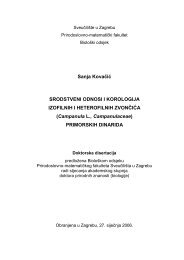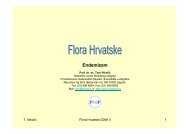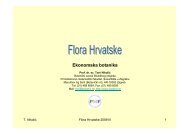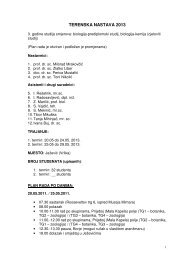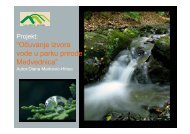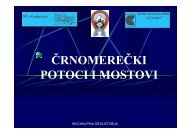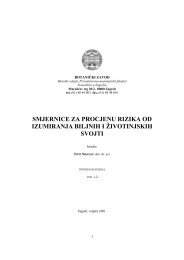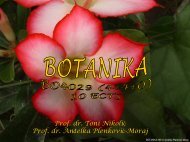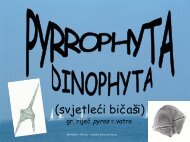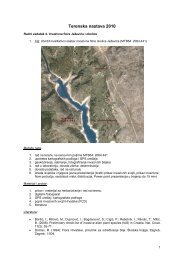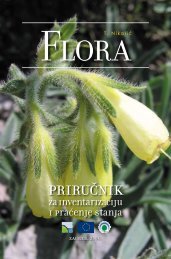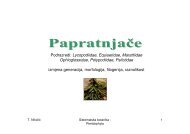important plant areas in central and eastern europe - hirc.botanic.hr ...
important plant areas in central and eastern europe - hirc.botanic.hr ...
important plant areas in central and eastern europe - hirc.botanic.hr ...
You also want an ePaper? Increase the reach of your titles
YUMPU automatically turns print PDFs into web optimized ePapers that Google loves.
Section 5Methodology summaryCriteria summary: there is a wide range of globally, regionally <strong>and</strong> nationally t<strong>hr</strong>eatenedtaxa <strong>in</strong> Criterion A. Of these, 93 taxa are nationally t<strong>hr</strong>eatened endemic or limited rangetaxa with no European or global recognition. Ten EUNIS Level 2 habitats were assessedfor <strong>botanic</strong>al richness, <strong>in</strong>clud<strong>in</strong>g 19 types of unique Romanian habitats, not yetrecognised for their European importance, which could not be assessed under CriterionC. Criterion C also has a wide range of habitats but more of Romania’s t<strong>hr</strong>eatenedhabitats should be recognised at the European level.Data <strong>and</strong> fieldwork: at the beg<strong>in</strong>n<strong>in</strong>g of the project all available exist<strong>in</strong>g data werecollated <strong>and</strong> potential sites for field <strong>in</strong>vestigation selected.Two extensive field seasons onalmost 400 sites were carried out <strong>in</strong> 2003 <strong>and</strong> 2004.The majority of the data used forIPA identification were updated <strong>in</strong> the last two years.Site selection: accord<strong>in</strong>g to the project methodology, the national selection strategyfocussed on select<strong>in</strong>g sites of different sizes (from one ha up to 38,000 ha) depend<strong>in</strong>gon the qualify<strong>in</strong>g features <strong>and</strong> the ecological situation. Sites were selected <strong>in</strong>side <strong>and</strong>outside the exist<strong>in</strong>g protected area network. Conservation priority level was also a keyelement <strong>in</strong> selection.Key issues: lower <strong>plant</strong>s <strong>and</strong> fungi were fully <strong>in</strong>tegrated <strong>in</strong>to the site selection procedure.The lack of up-to-date <strong>and</strong> <strong>central</strong>ised <strong>in</strong>formation on flora <strong>and</strong> habitats was a significantproblem at the start of the project. For this reason, the exist<strong>in</strong>g data was checked <strong>in</strong> thefield <strong>and</strong> the IPA project provided the impetus for the first national database oft<strong>hr</strong>eatened <strong>plant</strong> <strong>and</strong> habitat locations. 3,000 leaflets <strong>and</strong> a guide to the identification ofIPAs <strong>in</strong> Romania were published, <strong>and</strong> the ‘Important Plant Areas <strong>in</strong> Romania’ book will bepublished <strong>in</strong> 2005.This will ensure that decision makers, scientists, students <strong>and</strong> thegeneral public will have access to this <strong>in</strong>formation.Protection <strong>and</strong> management of IPAs:Total IPAs with National National protection European InternationalIPAs no legal protection of IPAs (lower level) recognition recognitionprotection of IPAs of IPAs of IPAs(high level)276 66 National Park Natural Park (2 IPAs) IBA (2) Ramsar (3)(49 IPAs)Nature Reserve Geological Biosphere(133 IPAs) Reserve(1 IPA) Reserves(22 IPAs)Nature Monument(3 IPAs)As the most sensitive <strong>areas</strong> for t<strong>hr</strong>eatened <strong>plant</strong> <strong>and</strong> habitat conservation, all IPAsrequire national protection <strong>and</strong> special management to ensure their ma<strong>in</strong>tenance orrestoration. Consequently the 66 IPAs located outside the exist<strong>in</strong>g protected <strong>areas</strong> <strong>in</strong>Romania need to become nationally protected. More research is also needed to providethe scientific background for the correct management of sites accord<strong>in</strong>g to the aims of<strong>in</strong> situ conservation. Unique populations of t<strong>hr</strong>eatened <strong>plant</strong>s such as Andryalalevitomentosa, Astragalus peterfii, Centaurea pontica, Centaurea jankae, L<strong>in</strong>um pallasianum ssp.borzeanum,<strong>and</strong>Stipa danubialis will shortly disappear without special management,<strong>in</strong>clud<strong>in</strong>g re<strong>in</strong>troduction.52



